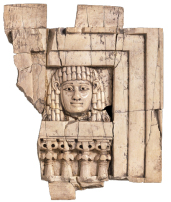Text
The first millennium incantation corpus known as Beschwörungsrituale an Ištar und Dumuzi describes the goddess or the demoness Kilili as “the woman leaning from the window” (ša apāta ušarru). Even though Kilili is commonly identified as “a female demon,” she is, however, clearly equated with Ištar (rabītu Ištar) in this same context (A.1a.34). In these rituals that feature both Ištar and Dumuzi, and in which Ištar is able to cure and inflict disease, she acts as the leader of the demons, and occasionally also becomes identified as a demon herself. Despite being a female demon, Kilili is connected with wisdom. This fact is stressed in the above mentioned texts where, after the description of Kilili leaning from the window, the text continues (A.1a.22-23): “You are Kilili … the wisest of the wise, who concerns herself in the matters of people.” In the apotropaic ritual series Bīt mēseri, the wise goddess sitting at the window is identified with Ištar: “at the window of the house sits wise Ištar”. A similar epithet “the wisest of the wise” appears in the list of love songs (KAR 158.3.7’) and therefore is likely to refer to Inanna/Ištar: “the wisest of the wise (women), overseer of the people.” Thus it is evident that the female at the window is the wise Ištar, identified with the wise Kilili. In Inanna D 105-106, Inanna is equated with a prostitute who, like a ghost, slips through or leans from a window like a ghost: “As a prostitute you go down to the tavern, and (there) you will turn into a ghost leaning from the window”. In Lu Excerpt 2.176-179a (MSL 12.109) the same ghost (ab-ba šú-šú) is equated with Kilili (ki-li-li). In other words, according to Inanna D, Inanna goes down to the tavern and turns into Kilili leaning from the window.
The image of the “woman at the window” is also used to describe Tašmetu, Nabû’s consort, e.g., “in the period of five days of Tašmetu-of-the-window-opening” (Aššur Photo 4062:6). By being Nabû’s consort, Tašmetu most certainly shared aspects with Nabû’s other wife, Nanaya, who, of course, is none other than Inanna/Ištar. In addition to the window, Tašmetu is also associated with the wall. In the Love Lyrics of Nabû and Tašmetu, Tašmetu is called “the one of the wall” (ša dūri). To confirm Tašmetu’s association with the wall, a mural crown - known as kilīlu - is placed on Tašmetu’s head in the Love Lyrics (l. 21). The usual explanation for the mural crown motif has been that the motif of the goddess “of the wall,” protecting the city and its people, is repeated in the mural crown, imitating the (protective) nature of the wall.
The window acting as a link between two worlds also occurs in a Bahiric parable on the exegesis of the first letter of the Torah, beth, as a symbol of the lower wisdom, in other words with the “lower Ḥokhmah,” identified with the Shekhinah (S 36, M 54): a king married his beautiful daughter to a prince, giving her garments, a crown, jewelry and enormous wealth. The king, however, could not live without his daughter, but he could not live with her either. Thus he built a window between himself and her, and whenever they needed one other, they could reach one another through the window. Thus the daughter, the Shekhinah, was wed to a prince in the corporeal world, but remained connected with her father in the heavenly world. The enormous wealth the king gave to his daughter is a metaphor for the “impregnation” of the Shekhinah: since the Shekhinah is feminine and passively receptive in character, and has nothing of her own, she must be adorned and presented with gifts - adornments and gifts representing the other Sefirot flowing into her.
A window, a doorway, a wall and a mountain all create a link between the two worlds: the human and the divine. The ultimate link here is, of course, the goddess herself representing the divine world with which the human individual seeks to unite. Therefore, the motif of the beautiful woman or a goddess looking through the window as if she was waiting for someone can be seen as an iconographical representation of an opening to the divine world. In the Mesopotamian evidence, this woman is Inanna/Ištar, the heavenly queen, but who is also known as Kilili, a female demon associated with owls and the netherworld. She shares characteristics with the Greek Athena, whose symbol was the owl and who also was a chthonic goddess. On the other hand, the window is also connected with Nabû’s consort Tašmetu. Another wife of Nabû is Nanaya (= Inanna/Ištar), and thus Tašmetu and Nanaya must at least share aspects or be more or less identified with each other. The motif of the beautiful woman luring the perfect man to approach her is found in Jewish mysticism where the Shekhinah stands in a doorway and reveals her face only to those worthy of her. All these facts seem to make the equation Inanna/Ištar = Kilili = Nanaya = Tašmetu = the Shekhinah = the woman at the window (doorway) = a link to the divine world.
Sources (list of abbreviations) (source links will open in a new browser window)
Beschwörungsrituale an Ištar und Dumuzi A.1a.22-23
Beschwörungsrituale an Ištar und Dumuzi A.1a.34
Inanna D 15-16
KAR 158.3.7’
Love Lyrics of Nabû and Tašmetu
Lu Excerpt 2.176-179a
MSL 12.109
Bibliography
| Lapinkivi 2004, 232-240 | Lapinkivi, Pirjo. The Sumerian Sacred Marriage in the Light of Comparative Evidence. State Archives of Assyria Studies 15. Helsinki: The Neo-Assyrian Text Coprus Project 2004. |
Pirjo Lapinkivi
URL for this entry: http://www.aakkl.helsinki.fi/melammu/database/gen_html/a0001398.php
|

